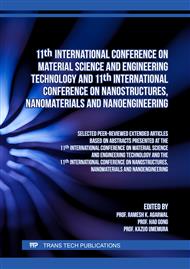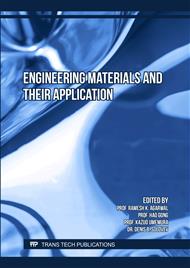[1]
R. C. Advincula, J. R. C. Dizon, E. B. Caldona, R. A. Viers, F. D. C. Siacor, R. D. Maalihan & A. H. Espera Jr., On the progress of 3D-printed hydrogels for tissue engineering, MRS Communications (2021).
DOI: 10.1557/s43579-021-00069-1
Google Scholar
[2]
M. Espino, B. Tuazon, G. Robles, J. Dizon, Application of Taguchi Methodology in Evaluating the Rockwell Hardness of SLA 3D Printed Polymers, Materials Science Forum, ISSN: 1662-9752, Vol. 1005 (2020), pp.166-173
DOI: 10.4028/www.scientific.net/msf.1005.166
Google Scholar
[3]
J.R.C. Dizon, A.D. Valino, L.R. Souza, A.H. Espera, Jr., Q.Chen, R.C. Advincula, Three-Dimensional-Printed Molds and Materials for Injection Molding and Rapid Tooling Applications, MRS Communications, Vol 9, 2019, pp.1267-1283.
DOI: 10.1557/mrc.2019.147
Google Scholar
[4]
B. J. Tuazon, N. A. V. Custodio, R. B. Basuel, L. A. Delos Reyes, & J. R. C. Dizon, 3D Printing Technology and Materials for Automotive Application: A Mini-Review. In Key Engineering Materials, Vol. 913, 2022, p.3–16. Trans Tech Publications, Ltd.
DOI: 10.4028/p-26o076
Google Scholar
[5]
S. Crump, Fast, Precise, Safe Prototype with FDM, ASME PED, vol. 50, 1991, p.53–60.
Google Scholar
[6]
B. Tuazon, M. Espino, J. Dizon, Investigation on the Effects of Acetone Vapor-Polishing to Fracture Behavior of ABS Printed Materials at Different Operating Temperature, Materials Science Forum, ISSN: 1662-9752, Vol. 1005 (2020), pp.141-149
DOI: 10.4028/www.scientific.net/msf.1005.141
Google Scholar
[7]
J. C. Dizon, C. C. L. Gache, H. M. S. Cascolan, L. T. Cancino, R. C. Advincula, Post processing of 3D-printed Polymers, Technologies, 2021, 9(3):61.
DOI: 10.3390/technologies9030061
Google Scholar
[8]
Information on https://www.hubs.com/knowledge-base/what-is-fdm-3d-printing/#what-are-the-disadvantages-of-fdm-3d-printing
Google Scholar
[9]
Jeevi G., Nayak S.K., Abdul Kader M., Review on adhesive joints and their application in hybrid composite structures, J. Adhes. Sci. Technol., 33 (2019), p.1497
DOI: 10.1080/01694243.2018.1543528
Google Scholar
[10]
Bak K.M., Kalaichelvan K., Vijayaraghavan G.K., Dinesh M., Arumugam V., Study on the effect of adhesive thickness of single lap joints using acoustic emission and FEA, Insight, Non-Destr. Test. Cond. Monit., 55 (2013), pp.35-41
DOI: 10.1784/insi.2012.55.1.35
Google Scholar
[11]
Information on https://formlabs.com/asia/blog/how-to-create-models-larger-than-your-3d-printers-build-volume/
Google Scholar
[12]
R. N. M. Delda, B. J. Tuazon, J. R. C. Dizon, Assessment of Interfacial Adhesion of Adhesively Bonded 3D - Printed Thermoplastics, Materials Science Forum, ISSN: 1662-9752, Vol. 1005 (2020), pp.157-165
DOI: 10.4028/www.scientific.net/msf.1005.157
Google Scholar
[13]
Ramalho L.D.C., Campilho R.D.S.G., Belinha J., da Silva L.F.M. Static strength prediction of adhesive joints: A review Int. J. Adhes. Adhes., 96 (2020), Article 102451
DOI: 10.1016/j.ijadhadh.2019.102451
Google Scholar
[14]
Shang X., Marques E.A.S., Machado J.J.M., Carbas R.J.C., Jiang D., da Silva L.F.M. Review on techniques to improve the strength of adhesive joints with composite adherends Composites B, 177 (2019), Article 107363
DOI: 10.1016/j.compositesb.2019.107363
Google Scholar
[15]
Abdel Wahab M.M., Fatigue in adhesively bonded joints: A review. Int. Sch. Res. Not., (2012)
Google Scholar
[16]
Budhe S., Banea M.D., De Barros S., Da Silva L.F.M., An updated review of adhesively bonded joints in composite materials, Int. J. Adhes. Adhes., 72 (2017), pp.30-42
DOI: 10.1016/j.ijadhadh.2016.10.010
Google Scholar
[17]
Information on https://www.merriam-webster.com/dictionary/adherend
Google Scholar
[18]
Harris CG, Jursik NJS, Rochefort WE and Walker TW, Additive Manufacturing with Soft TPU – Adhesion Strength in Multimaterial Flexible Joints. Front. Mech. Eng. (2019) 5:37.
DOI: 10.3389/fmech.2019.00037
Google Scholar
[19]
Spaggiari A., Denti F. Mechanical strength of adhesively bonded joints using polymeric additive manufacturing Proc. Inst. Mech. Eng. C (2019), Article 0954406219850221
Google Scholar
[20]
Cavalcanti D.K.K., Banea M.D., Queiroz H.F.M., Mechanical characterization of bonded joints made of additive manufactured adherends, Ann. "Dunarea de Jos" Univ. Galati. Fasc. XII Weld. Equip. Technol., 30 (2019), pp.27-33
DOI: 10.35219/awet.2019.04
Google Scholar
[21]
M. R. Khosravani, P. Soltani, K. Weinberg, T. Reinicke, Structural integrity of adhesively bonded 3D-printed joints, Polymer Testing, Vol. 100, 2021, 107262, ISSN 0142-9418
DOI: 10.1016/j.polymertesting.2021.107262
Google Scholar
[22]
V. Kovan, G. Altan and E. S. Topal, "Effect of layer thickness and print orientation on strength of 3D printed and adhesively bonded single lap joints", Journal of Mechanical Science and Technology 31 (5) (2017) 2197-2201.
DOI: 10.1007/s12206-017-0415-7
Google Scholar
[23]
M. Hafsa, M. Ibrahim, Md. Wahab, Saidin, and M. Zahid, Evaluation of FDM pattern with ABS and PLA material. Applied Mechanics and Materials (2013), 465-466. 55-59.
DOI: 10.4028/www.scientific.net/amm.465-466.55
Google Scholar
[24]
ASTM D3163-01: Standard Test Methods for Determining the Strength of Adhesively Bonded Rigid Plastic Lap-Shear Joints in Shear by Tension Loading. ASTM.
DOI: 10.1520/d3163-01r08
Google Scholar
[25]
Information on https://www.matterhackers.com/news/how-to-make-abs-juice-glue-and-slurry
Google Scholar
[26]
S. Ebnesajjad, Theories of Adhesion in Surface Treatment of Materials for Adhesive Bonding (Second Edition), (2014)
Google Scholar
[27]
Omairey, S., Jayasree, N. & Kazilas, M. Defects and uncertainties of adhesively bonded composite joints. SN Appl. Sci. 3, 769 (2021)
DOI: 10.1007/s42452-021-04753-8
Google Scholar
[28]
Information on https://www.doitpoms.ac.uk/tlplib/add_manuf/fdm.php
Google Scholar



